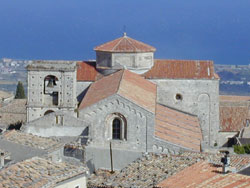Roman Catholic Diocese of Locri-Gerace
|
Diocese of Locri-Gerace Dioecesis Locrensis-Hieracensis |
|
|---|---|

Co-cathedral in Gerace
|
|
| Location | |
| Country | Italy |
| Ecclesiastical province | Reggio Calabria-Bova |
| Statistics | |
| Area | 1,248 km2 (482 sq mi) |
| Population - Total - Catholics |
(as of 2013) 133,000 (est.) 122,000 (est.) (91.7%) |
| Parishes | 74 |
| Information | |
| Denomination | Catholic Church |
| Rite | Roman Rite |
| Established | 5th century |
| Cathedral | Cattedrale di S. Maria del Mastro (Locri) |
| Co-cathedral | Concattedrale di S. Maria Assunta (Gerace) |
| Secular priests | 63 (diocesan) 29 (Religious Orders0 |
| Current leadership | |
| Pope | Francis |
| Bishop | Francesco Oliva |
| Map | |
 |
|
| Website | |
| www.diocesilocri.it | |
The Italian Catholic Diocese of Locri-Gerace (Latin: Dioecesis Locrensis-Hieracensis ) is in Calabria. It is a suffragan of the Archdiocese of Reggio Calabria-Bova.
Historically it was the Diocese of Gerace, becoming in 1954 the Diocese of Gerace-Locri and taking the current name in 1986.
Gerace probably owes its origin, or at least its importance, to the ruin of the town of Locri Epizephyrii, one of the earliest Greek colonies in Lower Italy, founded by the Ozolian Locrians (684-680 B.C.) and endowed with a code of laws by Zaleucus. The town was in a favorable position for the exploitation of the rich fields along the coast of the Gulf of Taranto, and sharing in the commerce of the east-west trade route. Locri, however, was a beachfront town, wide-open to attacks by pirates and then by Arabs, Moors, and Saracens. Before its total ruin, Locri Epizephrii had a bishop of its own; but in 709, under Bishop Gregory, the see was transferred to Gerace. Gerace had the advantage of being a fortifiable hilltop, where the population could protect itself from raiders. There was only one bishop and one diocese, however, first called Locri and then called Gerace. These were not two dioceses.
In 731, Gerace and all the towns of Calabria suffered from a major earthquake, which devastated many of the cities of the region. There was another major earthquake in 1783, and one in 1908.
The name Gerace is probably derived from Saint Cyriaca, whose church was destroyed by the Saracens in 915. They captured the town in 986, but in 1059 it fell into the hands of the Normans. The Normans began the turn away from Greek affiliations toward Rome, aided by the policies of Gregory VII and Urban II.
Until 1467 the Greek Rite was in wide use at Gerace, and such had probably been the custom from the beginning. As early as the thirteenth century efforts were made to introduce the Latin Rite, which accounts for the schism between Latins and Greeks about 1250-1253. The latter demanded as bishop the monk Bartenulfo, a Greek, whereas Pope Innocent IV, in 1253, appointed Marco Leone. In 1467, bishop Atanasio Calceofilo introduced the Latin Rite.
...
Wikipedia
